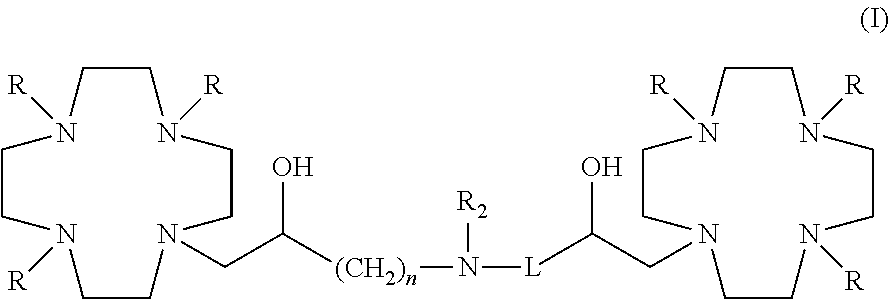Dimeric contrast agents
a contrast agent and dimeric technology, applied in the field of diagnostic imaging, can solve the problems of shortening the acquisition time of the imaging process, extremely toxic free metal ions [gd, sup>3+/sup>, extremely toxic to living organisms, etc., and achieve the effect of improving relaxivity and favorable characteristics
- Summary
- Abstract
- Description
- Claims
- Application Information
AI Technical Summary
Benefits of technology
Problems solved by technology
Method used
Image
Examples
example 1
on of the Substrate 18
[0204]
[0205]This compound was obtained by using the synthetic procedure shown in Scheme 3:
[0206]
[0207]comprising:
[0208]a) Preparation of Compound 1B.
[0209]Commercially available epichlorohydrin 2 (10.5 mL; 137 mmol) was dissolved in acetonitrile (300 mL) and the resulting solution was slowly added at room temperature to a solution of DO3A tris-t-butyl ester 1A (Org. Synth. 2008, 85, 10) (14.1 g; 27.4 mmol) in acetonitrile (100 mL). The mixture was stirred for 24 h then more epichloridrin 2 (5.2 mL; 68 mmol) was added. After 24 h the mixture was evaporated and the residue purified by chromatography on silica gel (eluent: CH2Cl2 / MeOH=50:1→4:1) to give compound 1C (10.6 g). Yield 64%.
[0210]1H-NMR, 13C-NMR and mass spectrum were consistent with the expected structure.
example 2
on of the Chelate Complex 1
[0211]
[0212]This dimeric compound was prepared using the procedure of the following general Scheme 4:
[0213]
[0214]including:
[0215]a) Preparation of 1
[0216]Benzyl chloroformate (95%; 18.85 g; 105 mmol) was added in 1 h to a mixture of diallylamine (commercially available) (9.7 g; 100 mmol), K2CO3 (34.5 g; 250 mmol), water (150 mL) and EtOAc (150 mL) at 0° C. After stirring for 6 h, the organic phase was separated and extracted with 1 N HCl (2×100 mL), water (100 mL) and brine (100 mL). The organic phase was dried (Na2SO4) and evaporated to give 1 (22 g). Yield 95%.
[0217]1H-NMR, 13C-NMR and mass spectrum were consistent with the expected structure.
[0218]b) Preparation of Protected Bridging Molecule 2
[0219]A solution of 3-chloroperbenzoic acid (MCPBA) (75%; 34.5 g; 150 mmol) in dichloromethane (100 mL) was added dropwise to a solution of intermediate 1 (11.6 g; 50 mmol) in dichloromethane (100 mL). The solution was stirred at room temperature for 16 h. More MC...
example 3
on of the Chelate Complex 3
[0237]
[0238]This complex compound was obtained by using the procedure shown in Scheme 5:
[0239]
[0240]Including:
[0241]a) Preparation of 2
[0242]Commercially available epichlorohydrin (4.1 mL; 52 mmol) was added to a solution of commercially available D-glucamine 1 (1.9 g; 10.5 mmol) in MeOH (110 mL). The mixture was stirred at 50° C. for 26 h then evaporated to give the bridging molecule 2 as a colourless oil that was directly used for the next reaction without any further purification. Quantitative yield.
[0243]1H-NMR, 13C-NMR and mass spectrum were consistent with the expected structure.
[0244]b) Preparation of 3
[0245]A solution of Substrate 1A (Org. Synth. 2008, 85, 10) (10.7 g; 21 mmol) in acetonitrile (14 mL) was added to a solution of compound 2 (3.8 g; 10.5 mmol) in DMSO (14 mL) and Et3N (4.3 mL). The mixture was stirred at 70° C. for 72 h then evaporated. The residue was purified by chromatography on Amberlite XAD 1600 (eluent: gradient of water / MeCN) t...
PUM
| Property | Measurement | Unit |
|---|---|---|
| pH | aaaaa | aaaaa |
| proton Larmor frequency | aaaaa | aaaaa |
| proton Larmor frequency | aaaaa | aaaaa |
Abstract
Description
Claims
Application Information
 Login to View More
Login to View More - R&D
- Intellectual Property
- Life Sciences
- Materials
- Tech Scout
- Unparalleled Data Quality
- Higher Quality Content
- 60% Fewer Hallucinations
Browse by: Latest US Patents, China's latest patents, Technical Efficacy Thesaurus, Application Domain, Technology Topic, Popular Technical Reports.
© 2025 PatSnap. All rights reserved.Legal|Privacy policy|Modern Slavery Act Transparency Statement|Sitemap|About US| Contact US: help@patsnap.com



